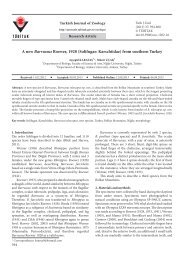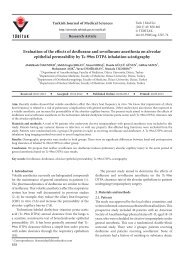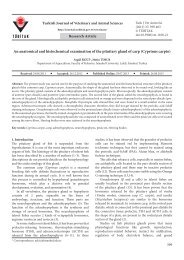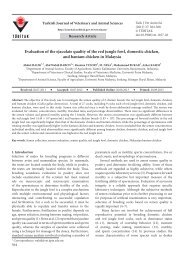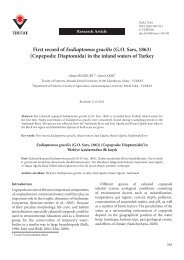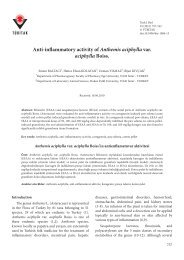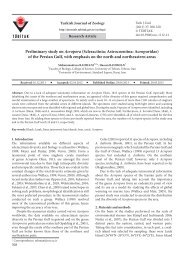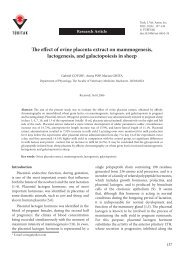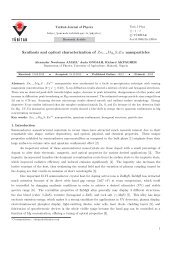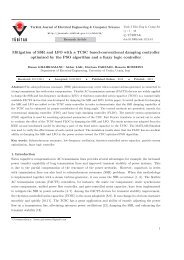A highly soluble asymmetric perylene-bis (dicarboximide)-acceptor ...
A highly soluble asymmetric perylene-bis (dicarboximide)-acceptor ...
A highly soluble asymmetric perylene-bis (dicarboximide)-acceptor ...
Create successful ePaper yourself
Turn your PDF publications into a flip-book with our unique Google optimized e-Paper software.
Turk J Chem<br />
33 (2009) , 727 – 737.<br />
c○ TÜBİTAK<br />
doi:10.3906/kim-0811-33<br />
A <strong>highly</strong> <strong>soluble</strong> <strong>asymmetric</strong> <strong>perylene</strong>-<strong>bis</strong><br />
(<strong>dicarboximide</strong>)-<strong>acceptor</strong> system incorporating a<br />
methylene bridged methoxybenzene-donor: solvent<br />
dependence of charge transfer interactions<br />
René M. WILLIAMS<br />
Molecular Photonics Group, Van ’t Hoff Institute for Molecular Sciences,<br />
Faculty of Science, Universiteit van Amsterdam, Nieuwe Achtergracht 129,<br />
1018 WS Amsterdam-THE NETHERLANDS<br />
e-mail: R.M.Williams@uva.nl<br />
Received 24.11.2008<br />
The synthesis and photophysical properties of an <strong>asymmetric</strong>ally substituted <strong>perylene</strong>-<strong>bis</strong>(<strong>dicarboximide</strong>),<br />
(PDI), system (1) containing a methylene bridged 4-methoxy-benzene donor and a solubilizing branched<br />
C 13<br />
alkyl chain are described. As compared to most PDIs, the fluorescence of 1 is strongly quenched in<br />
polar (but not in non-polar) solvents due to a photo-induced electron transfer process. Transient absorption<br />
spectroscopy and time resolved emission in e.g. acetonitrile indicates that upon excitation the radical anion<br />
of the PDI is formed with a rate of ca. 3.5 × 10 9 s −1 , and the charge transfer state has a lifetime of ca. 3<br />
ns. A Frontier Molecular Orbital description is provided, by using DFT calculations.<br />
Key Words: Perylene dyes, photoconductivity, solar cells, LED, 3,4,9,10-<strong>perylene</strong>tetracarboxylic diimide,<br />
excited state properties, photoinduced electron transfer, transient absorption, time resolved emission<br />
Introduction<br />
Perylene-<strong>bis</strong>(<strong>dicarboximide</strong>s) are extremely stable organic dyes of which the chemistry has been explored in many<br />
directions and which have been applied in many fields ranging from car paints, hair-treatment compositions,<br />
active conducting components in photocopying devices, to laser dyes. 1 The electron accepting abilities of<br />
<strong>perylene</strong>-<strong>bis</strong>(<strong>dicarboximide</strong>s) (PDIs) make them interesting components for electron transfer systems 2 and<br />
for application in opto-electronic devices. Several examples have been reported where <strong>perylene</strong> dyes are the<br />
727
A <strong>highly</strong> <strong>soluble</strong> <strong>asymmetric</strong> <strong>perylene</strong>-<strong>bis</strong>..., R. M. WILLIAMS<br />
n-type material in organic solar cells. 3,4 Alkoxybenzene groups as donor units for charge transfer PDIs can be<br />
easily incorporated into supramolecular functionality and allow selective <strong>perylene</strong><strong>bis</strong>imide excitation. 5,6<br />
The synthesis of <strong>asymmetric</strong>ally substituted PDIs is not trivial and 3 methods are available: via the<br />
mono-potassium salt of <strong>perylene</strong>-3,4,9,10-tetracarboxylic-dianhydride (PTCDA) in a reaction in water; 7 by<br />
using a reaction of PTCDA with equimolar amounts of 2 similar amines in the standard coupling in imidazole<br />
followed by separation of the statistical mixture formed; 2,8 via a symmetric PDI, followed by hydrolysis with<br />
base to the mono-imide-mono-anhydride and subsequent coupling with a second amine. 9 The first (water based)<br />
method was recently described with (S)-(-)-1-phenylethylamine. 10 Using ammonia as the first reagent in the<br />
water based method can result in <strong>asymmetric</strong> PDI systems that can be functionalized further by N-alkylation. 11<br />
Here a PDI system containing a 4-methoxybenzene donor and a solubilizing branched C 13 alkyl chain<br />
is presented and its photophysical properties are investigated. The <strong>asymmetric</strong> compound is synthesized by<br />
the reaction in water of the mono-potassium salt 7 of the PTCDA with 4-methoxybenzylamine, followed by the<br />
standard coupling 12 of the mono-imide-mono-anhydride in imidazole with 1-hexylheptylamine to obtain the<br />
<strong>asymmetric</strong>ally substituted PDI 1.<br />
Scheme 1. The electron donor-<strong>acceptor</strong> system 1.<br />
Experimental<br />
Synthesis<br />
Perylene-3,4,9,10-tetracarboxylic acid monoanhydride monopotassium carboxylate (monopotassium<br />
salt of PTCDA)<br />
3 g of <strong>perylene</strong>-3,4,9,10-tetracarboxylic-dianhydride (Aldrich) was mixed with 35 mL of 5% KOH solution (pH<br />
= 10.5). At 90 ◦ C, in a period of 3 to 4 h, 12.5 mL of 10% phosphoric acid was added dropwise, until the pH<br />
was between 4.5 and 5.5. If a drop is put on filter paper now, there is a dark brown solid that does not migrate,<br />
and a colorless solvent that migrates through the paper. (At higher pH, the migrating solvent still contains<br />
yellow/green substance). After stirring for 1 h at 90 ◦ C, the monopotassium salt was isolated on a frit filter.<br />
If washed with water, material washed through the filter.<br />
Yield: 1.64 g (3.7 mmol); 47% Bordeaux-red amorphous material.<br />
IR(KBr): 1760(s), 1720(s), C=O, anhydride.<br />
728
A <strong>highly</strong> <strong>soluble</strong> <strong>asymmetric</strong> <strong>perylene</strong>-<strong>bis</strong>..., R. M. WILLIAMS<br />
N-(4-methoxybenzyl)-3,4,9,10-<strong>perylene</strong>tetracarboxylic-3,4-anhydride-9,10-imide (Perylene-monoimide-mono-anhydride)<br />
To a mixture of 4.5 mmol (0.48 g, 0.6 ml) 4-methoxybenzylamine in 45 mL of water at 0 to 5 ◦ C was added<br />
the monopotassium salt of PTCDA (1.1 mmol, 0.45 g). An immediate color change was observed. The mixture<br />
was allowed to react for 4 h without cooling, and was then warmed to 90 ◦ C over 2 h (the formed carboxamide<br />
is prone to hydrolysis and should not be left in solution overnight). Then 11.5 mL of 20% phosphoric acid<br />
was added. After 2 h, the precipitated product was isolated on a frit filter and washed with water. To remove<br />
<strong>bis</strong>imide and dianhydride the material was treated with 60 mL of 10% KOH for 2 h. The di-potassium salt<br />
of the monoimide precipitates. Complete precipitation is accomplished by adding a concentrated KCl solution<br />
(salting out). A drop on filter paper should migrate yellowish through the paper, not reddish.<br />
The precipitate is isolated on a frit filter after cooling, and washed with 8 % KCl and 2 % K 2 CO 3 ,until<br />
the filtrate is colorless (to remove the tetra-potassium salt of the <strong>bis</strong>-anhydride). The residue is dissolved in hot<br />
water and filtered to remove <strong>bis</strong>imide. From the filtrate the monoimide-mono-anhydride was isolated at 90 ◦ C<br />
by adding acid (HCl). The product was isolated and dried.<br />
Yield: 0.19 g (0.4 mmol); 36% black amorphous material.<br />
IR(KBr): 1765(s), 1730(m), C=O, anhydride; 1690(s),1650(s), C=O(imide).<br />
As can be read in reference 9d, this method only works with amines that are water <strong>soluble</strong>. It does not<br />
work with e.g. 1-hexylheptylamine.<br />
N-(1-hexylheptyl)-N ′ -(4-methoxybenzyl)-3,4,9,10-<strong>perylene</strong><strong>bis</strong>(<strong>dicarboximide</strong>) (Formation of the<br />
<strong>asymmetric</strong> PDI 1)<br />
To5gofimidazoleand330mg(1.66mmol)hexylheptylaminewasadded100mg(0.196mmol)ofmono-imidemono-anhydride,<br />
and the mixture was heated at 160 ◦ C under N 2 for 4 h.<br />
To the cooled-down mixture were added 100 mL of ethanol and 300 mL of 2 M HCl. This mixture was<br />
extracted with dichloromethane, which was then washed with water and NaOH. The solvent was removed. The<br />
compound was purified by column chromatography (3 times), using chloroform as eluent, (TLC, CHCl 3 ,d<br />
= 0.25 mm, Rf = 0.2). The material can be crystallized from chloroform-acetone mixtures, or from boiling<br />
cyclohexane to which drops of chloroform or acetone are added to dissolve all material and slow cooling to room<br />
temperature.<br />
Yield: 100 mg = 0.14 mmol = > 73% shiny reddish-pink material.<br />
The official CAS name of this compound 1 is expected to be:<br />
Anthra[2,1,9-def:6,5,10-d’e’f’]diisoquinoline-1,3,8,10(2H,9H)-tetrone, 2-(1-hexylheptyl)-9-[4-methoxyphenyl]methyl].<br />
Spectroscopic data for 1: IR (CHCl 3 ): 3200(w), 3020(m) C=C; 2950(s), 2920(s), 2850(s), CH; 1650(s),<br />
1690(s) C=O (imide); 1610(w), 1590(m), 1575(w), C=C. 1 H-NMR (CDCl 3 , 250 MHz): δ 0.81, t, 6H, J = 6.6<br />
Hz, (Me); 1.22-1.32, 16H, (alkyl); 1.83-1.91, m, 2H, CH 2 CHN; 2.22-2.31, m, 2H ,CH ′ 2 CHN; 3.75, s, 3H, (MeO):<br />
5.14-5.21, tt, 1H, J 1 =10Hz,J 2 = 5.8 Hz, (CHN); 5.26, s, 2H, (NCH 2 ph); 6.85, d, 2H, J = 8.6 Hz, (ph) ; 7.53,<br />
d, 2H, (ph); 8.28, d, 2H, J 1 =8Hz,J 2 = 3.15 Hz, (per); 8.40, dd, 4H, J 1 =8Hz,J 2 = 2.3 Hz, (per); 8.58, d<br />
(broad), 2H, (per). 13 C-NMR (CDCl 3 ,63MHz); δ = 4.03, (Me); 22.60, (CH 2 ); 27.01, (CH 2 ); 29.25, (CH 2 );<br />
729
A <strong>highly</strong> <strong>soluble</strong> <strong>asymmetric</strong> <strong>perylene</strong>-<strong>bis</strong>..., R. M. WILLIAMS<br />
31.78, (CH 2 ); 32.45, (CH 2 ); 43.12, (NCH 2 ph); 54.90, (CHN); 55.27, (MeO); 113.85, (ph); 122.69, 122.95 (CH<br />
per); 123.04, 126.14, 129.00, 129.41, (C q per); 130.80, (ph); 131.24, (CH per), 134.04, (C q per);134.48, (C q ph);<br />
159.17, (C q O ph); 163.09, (CO).<br />
MS FAB + MH + 693.3328 (calcd); 693.3313 (obsd). ε of 1 is 87700 M −1 cm −1 at 528 nm in CHCl 3<br />
NMR Double-resonance: When irradiated at 5.19 ppm, the signals at 1.9 and 2.25 ppm change from<br />
multiplets to 2 triplets. The CH 2 CHN and CH ′ 2 CHN protons have a different chemical environment due to the<br />
presence of the carbonyl groups.<br />
Melting point: (red needles from cyclohexane-acetone): 312.8-313.5 ◦ C<br />
Purity was checked by HPLC (reversed phase, C 18 column, acetonitrile as eluent, flow = 1 ml/min, P =<br />
20 Mpa, Rt = 2.7 min), which indicated 99.9 + % purity.<br />
Scheme 2. Synthetic route to charge transfer PDI system 1.<br />
Details on the spectroscopic methods (SPC and transient absorption spectroscopy) are reported elsewhere. 13<br />
Emission quantum yields were determined with the “optical dilute relative” method 14 on a SPEX Fluorolog,<br />
using Rhodamine 101 in ethanol as a reference. 15<br />
For the spectroscopy, heating with a hot-air pistol was used to prepare the solutions (when needed) and<br />
filtration over a cotton plug was applied to remove particles.<br />
Molecular modeling was performed with the Spartan’04 V1.03 package (Wavefunction Inc.) The equilibrium<br />
geometry in the ground state was calculated using Density Functional B3LYP with 6-31G. Orbitals were<br />
visualized at 0.01 electrons/au 3 .<br />
730
A <strong>highly</strong> <strong>soluble</strong> <strong>asymmetric</strong> <strong>perylene</strong>-<strong>bis</strong>..., R. M. WILLIAMS<br />
Results and discussion<br />
The shape of the absorption and emission spectra of 1 are very common (see Figure 1) and the UV-Vis absorption<br />
spectrum of 1 is only slightly solvent dependent and shows 3 characteristic (average) maxima around 455, 486,<br />
and 522 nm (π → π ∗ transitions) and a shoulder at ∼430 nm. As compared to most PDIs, 16 however, the<br />
fluorescence of 1 (with maxima average around 530, 570, and 620 nm) is strongly quenched in polar solvents.<br />
Representative UV-Vis absorption spectra in cyclohexane (with maxima at 517, 481, 451, 260, and 220 nm)<br />
and ethylacetate (with maxima at 520, 484, 454, and 260 nm) are given in Figure 1.<br />
Figure 1. UV-Vis absorption spectra (left) together with emission spectra (right) of 1 in cyclohexane (red) and in<br />
ethylacetate (blue).<br />
Emission maxima observed are 521, 559, and 609 nm in cyclohexane and 527, 565, and 616 nm in<br />
ethylacetate. It is interesting that the fluorescence quantum yields range from unity in n-hexane, to only a few<br />
percent in acetonitrile. Clearly a very strong solvent effect is occurring, in which the polarity of the solvents<br />
is of major importance. We attribute this quenching to a photoinduced electron transfer process. Emissive<br />
properties of 1 are given in Tables 1 and 2.<br />
Table 1. Solvent dependence of the fluorescence quantum yield (Φ f ), together with the Δf value of the solvents.<br />
Solvent Δf Φ f<br />
n-hexane 0.092 0.99<br />
Cyclohexane 0.100 0.73<br />
Toluene 0.126 0.67<br />
Dibutylether 0.194 0.42<br />
Chloroform 0.251 0.14<br />
Ethylacetate 0.292 0.10<br />
Dichloromethane 0.319 0.09<br />
Acetonitrile 0.393 0.07<br />
Δf is the solvent polarity parameter.<br />
Δf = (ε-1)/(2ε +1) - (n 2 -1)/(4n 2 +2)<br />
731
A <strong>highly</strong> <strong>soluble</strong> <strong>asymmetric</strong> <strong>perylene</strong>-<strong>bis</strong>..., R. M. WILLIAMS<br />
The rate with which this quenching process occurs can be inferred from time resolved emission measurements.<br />
The fluorescence lifetimes as obtained with single photon counting of 1 in various solvents are given in<br />
Table 2. As in the steady state measurements, a clear solvent effect is present and the lifetime becomes shorter<br />
in more polar solvents.<br />
Table 2. Solvent dependence of the fluorescence lifetime (τ f with χ 2 ) and derived rate of electron transfer (k cs),<br />
together with the dielectric constants (ε) ofthesolvents.<br />
solvent ε τ f (ps) χ 2 k cs (s −1 )<br />
n-hexane 1.88 3450 1.10 0<br />
c-hexane 2.34 3300 1.05 1.3 ×10 7<br />
ethylacetate 6.02 340 1.12 2.6 × 10 9<br />
acetonitrile 37.5 262 1.2 3.5 × 10 9<br />
A direct proof of charge separation is the fact that in polar solvents the radical anion of the PDI moiety<br />
can be observed with transient absorption spectroscopy. In the transient absorption spectra the clear features<br />
of the radical anion of the PDI are observed, with maxima at 700 and 840 nm. 6,17 Also localized at around<br />
700 nm is the S 1 -S n absorption of the PDI unit; however, its lifetime is only 340 ps (see Table 2) and is<br />
therefore not clearly distinguished. Furthermore, some emission can be observed around 620 nm, as a negative<br />
signal. Transient absorption spectroscopy and single photon counting of 1 in acetonitrile thus indicates that<br />
upon excitation the radical anion of the <strong>perylene</strong><strong>bis</strong>imide 6,17 is formed with a rate of ∼ 3.5 × 10 9 s −1 ,and<br />
the charge transfer state has a lifetime of ca. 3 ns (see Figures 2 and 3). The charge separation rates (k cs )<br />
were calculated with the following equation in which the lifetime in n-hexane was taken as τ ref . This lifetime<br />
is similar to that of other strongly emissive <strong>perylene</strong> <strong>bis</strong>(<strong>dicarboximide</strong>s). 16<br />
0.6<br />
0.5<br />
0.4<br />
0.3<br />
0.2<br />
0.1<br />
0.0<br />
-0.1<br />
600<br />
650<br />
700 750<br />
Wavelength (nm)<br />
800<br />
850<br />
900<br />
Figure 2. Time resolved emission of the electron donor<br />
<strong>acceptor</strong> system 1 in n-hexane (long lived in red) and<br />
ethylacetate (short lived in blue). Laserpulse is also shown<br />
(in black) (λ ex = 324 nm, FWHM = 19 ps, λ det = 570<br />
nm).<br />
Figure 3. Transient absorption spectra of the electron<br />
donor <strong>acceptor</strong> system 1 in ethylacetate (λ ex = 480 nm,<br />
incremental time delay is 1 ns).<br />
732
A <strong>highly</strong> <strong>soluble</strong> <strong>asymmetric</strong> <strong>perylene</strong>-<strong>bis</strong>..., R. M. WILLIAMS<br />
k cs =1/τ f − /τ ref<br />
Clearly, even with a moderately strong donor, such as methoxybenzene, in polar solvents fast photoinduced<br />
charge transfer occurs in the system, resulting in a <strong>highly</strong> polar state that has a reasonable lifetime.<br />
Stronger electron donors could be applied to achieve electron transfer interaction in non-polar media. The<br />
asymmetry allows solubilization and determination of the charge transfer properties in many different solvents,<br />
which will enable the design of new and improved functional molecules as e.g. photoconductors, components in<br />
molecular switches or sensors.<br />
Photo-excitation of this simple methoxybenzyl substituted <strong>perylene</strong> dye gives fast (3.5 × 10 9 s −1 )<br />
photoinduced intramolecular electron transfer, resulting in a dipolar state of which the <strong>perylene</strong><strong>bis</strong>imide radical<br />
anion can be observed for a few nanoseconds.<br />
Figure 4. Representation of the photoinduced process occurring in compound 1 leading to the formation of a charge<br />
transfer state consisting of the radical anion of the <strong>acceptor</strong> and the radical cation of the donor.<br />
By using the appropriate data we can estimate 18 the Gibbs energy of photoinduced electron transfer:<br />
(E 0 (D +. /D) is estimated 19,16 to be +1.4 V vs SCE, E 0 (A/A −. )isestimated 17 to be –0.73 V vs SCE and<br />
1 ΔE 0,0 is 2.31 eV. From these data we can expect that there is a negative Δ ET G 0 in polar solvents of ca. –0.18<br />
eV. From the fluorescence data it is clear that in the non-polar solvent n-hexane the charge transfer interaction<br />
is not occurring.<br />
Molecular Orbital description<br />
From the experimental data it is clear that in compound 1 a photoinduced electron transfer interaction<br />
is occurring in polar solvents. A simple frontier molecular orbital (FMO) description of this process in a<br />
Donor/Acceptor (D/A) system, in which the <strong>acceptor</strong> has the lowest excited state, is given in Figure 5.<br />
733
A <strong>highly</strong> <strong>soluble</strong> <strong>asymmetric</strong> <strong>perylene</strong>-<strong>bis</strong>..., R. M. WILLIAMS<br />
d*<br />
d*<br />
d*<br />
a*<br />
a<br />
hυ<br />
A<br />
D<br />
d<br />
excitation<br />
a*<br />
a<br />
d<br />
charge<br />
a*<br />
a<br />
d<br />
A * separation<br />
D A -. D +.<br />
charge recombination<br />
Figure 5. FMO representation of charge separation and charge recombination following local excitation of the <strong>acceptor</strong><br />
in a D/A system.<br />
The HOMOs and LUMOs of D and A are labeled d , d ∗ and a ,a ∗, respectively. Local <strong>acceptor</strong> excitation<br />
(a →a ∗) is followed by electron transfer involving orbital interactions between d and a, while charge<br />
recombination involves interactions between a ∗ and d . The FMO description is undoubtedly an oversimplification,<br />
which may, for example, neglect important interactions between charge-transfer configurations and<br />
locally excited configurations. 21 Nevertheless, it is a useful starting point 21 for identifying important orbital<br />
interactions. The obtained structure as well as the MOs of the full molecular system 1 isshowninFigure6,as<br />
obtained from DFT calculations using SPARTAN (Wavefunction Inc). Since donor and <strong>acceptor</strong> are incorporated<br />
in one molecule this implies: a (= HOMO-1),a ∗(= LUMO) and d (= HOMO). It is interesting that in<br />
this system the PDI orbitals are rather un-perturbed. 22,23 Furthermore, it can be seen that the HOMO located<br />
on the methoxybenzene unit is slightly delocalized via the bridging CH 2 group to the nitrogen atom of the<br />
imide.<br />
It is interesting that the energy difference between the HOMO-1 and the LUMO (2.53 eV) relates rather<br />
well to the 1 ΔE 0,0 , that is 2.31 eV. The experimental results, together with DFT MO calculations, indicate<br />
that the special properties of system 1 allow fast photoinduced charge separation.<br />
Conclusions<br />
By incorporating a methoxybenzene substituent with a methylene spacer onto the PDI nitrogen we drastically<br />
change the properties in a polar environment, relative to e.g. alkyl substituted systems. Charge transfer<br />
interactions between the donor unit (methoxybenzene) and the <strong>acceptor</strong> unit (<strong>perylene</strong>-<strong>bis</strong>(<strong>dicarboximide</strong>)) are<br />
clearly present. Charge transfer occurs on the ∼3 × 10 9 s −1 scale and charge recombination is ca. 10 times<br />
slower (3.3 × 10 8 s −1 ). The <strong>asymmetric</strong> electron donor <strong>acceptor</strong> system was synthesized using the water-based<br />
method starting form the mono-potassium salt of the PTCDA. DFT calculations are in agreement with these<br />
experimental observations and give insight into the orbitals involved in the charge separation process. This work<br />
could be used for a better design of molecular components in photoconductors and other opto-electronic devices.<br />
Furthermore, charge transfer PDI 1 can be considered as a fluorescence-intensity probe-molecule that is sensitive<br />
towards dielectric or electric field effects, that can occur in transmembrane potentials 24 or for probing polymer<br />
734
A <strong>highly</strong> <strong>soluble</strong> <strong>asymmetric</strong> <strong>perylene</strong>-<strong>bis</strong>..., R. M. WILLIAMS<br />
rheology and glass transitions. 25 Asymmetrically substituted <strong>perylene</strong>-<strong>bis</strong>-(<strong>dicarboximide</strong>s) can be considered<br />
as “colorful compounds, with a big potential ”.<br />
(a)<br />
(b)<br />
Figure 6. (A) Visualization of the relevant orbitals of 1 as obtained from DFT calculations, (using a value of 0.01<br />
electrons/au 3 ), together with the energies and part of the schematics from Figure 5. (B) 3D structure of compound 1<br />
as obtained from DFT calculations.<br />
Figure 7. Photograph of 2 solutions of 1 with the same concentration under a UV light (366 nm). The left<br />
cuvette displays the un-quenched system in non-polar (cyclohexane) environment. The right cuvette shows the<br />
electron transfer quenching in polar (ethylacetate) medium.<br />
735
A <strong>highly</strong> <strong>soluble</strong> <strong>asymmetric</strong> <strong>perylene</strong>-<strong>bis</strong>..., R. M. WILLIAMS<br />
Figure 7 visualizes the charge transfer properties of 1, displaying the dramatic change in luminescence<br />
intensity in different environment of the fluorescence-intensity molecular probe 1.<br />
Acknowledgment<br />
Prof. Dr. Jan W. Verhoeven and Prof. Dr. Fred Brouwer are thanked for initiating this research.<br />
References<br />
1. (a) Langhals, H. Heterocycles 1995, 40, 477-500. (b) Schmidt-Mende, L.; Fechtenkötter, A.; Müllen, K.; Moons,<br />
E.;Friend,R.H.;MacKenzie,J.D.Science, 2001 293, 1119-1122 (c) Schneider, M.; Hagen, J.; Haarer, D.; Mullen,<br />
K. Adv. Mater. 2000, 12, 351.(d) Color Chemistry: Syntheses, Properties, and Applications of Organic Dyes and<br />
Pigments; 3rd ed.; Zollinger, H.; VHCA and Wiley-VCH: Zürich and Weinheim, 2003.<br />
2. Oneil, M. P.; Niemczyk, M. P.; Svec, W. A.; Gosztola, D.; Gaines, G. L.; Wasielewski, M. R. Science 1992, 257,<br />
63-65.<br />
3. Tang, C. W. Appl. Phys. Lett, 1986, 48 (2), 183-185.<br />
4. Xue, J.; Uchida, S.; Rand, B. P.; Forrest, S. R. Appl. Phys. Lett. 2004 85, 5757-5759.<br />
5. (a) Würthner, F.; Chen, Z.; Hoeben, F. J. M.; Osswald, P.; You, C.-C.; Jonkheijm, P.; van Herrikhuyzen, J.;<br />
Schenning, A. P. H. J.; van der Schoot, P. P. A. M.; Meijer, E. W.; Beckers, E. H. A.; Meskers, S. C. J.; Janssen,<br />
R. A. J. J. Am. Chem. Soc. 2004, 126, 10611-10618. (b) Schenning, A. P. H. J.; van Herrikhuyzen, J.; Jonkheijm,<br />
P.; Chen, Z.; Würthner, F.; Meijer, E. W. J. Am. Chem. Soc. 2002, 124, 10252-10253.<br />
6. Hippius, C.; van Stokkum, I. H. M.; Gsanger, M.; Groeneveld, M. M.; Williams, R. M.; Würthner, F. J. Phys.<br />
Chem. C 2008, 112, 2476-2486.<br />
7. Tröster, H. Dyes Pigm. 1983, 4, 171-177.<br />
8. Baffreau, J.; Leroy-Lhez, S.; Van Anh, N.; Williams, R. M.; Hudhomme, P. Chem. Eur. J. 2008, 14, 4974-4992.<br />
9. (a) Langhals, H.; Saulich, S. Chem. Eur. J. 2002, 8, 5630-5643. (b) Wescott L. D.; Mattern, D. L. J. Org. Chem.<br />
2003, 68, 10058-10066 (c) Dincalp H.; Avcıbası, N.; Icli, S. J. Photochem. Photobiol. A: Chem. 2007 185, 1-12.(d)<br />
Kaiser, H.; Lindner, J.; Langhals, H. Chem. Ber 1991, 124, 529.<br />
10. Amiralaei, S.; Uzun, D.; Icil, H. Photochem. Photobiol. Sci., 2008, 7, 936-947.<br />
11. (a) Lindner, S. M.; Thelakkat M. Macromol. Chem. Phys. 2006, 207, 2084-2092; (b) Bauer, P.; Wietasch, H.;<br />
Lindner, S. M.; Thelakkat, M. Chem. Mater. 2007, 19, 88-94.<br />
12. Demmig, S.; Langhals, H. Chem. Ber.-Recl. 1988, 121, 225-230.<br />
13. Williams, R. M.; Zwier, J. M.; Verhoeven, J. W. J. Am. Chem. Soc. 1995, 117, 4093.<br />
14. Demas, J. N.; Crosby, G. A. J. Phys. Chem. 1971, 75, 991-1024.<br />
15. Eaton, D. F. Pure & Appl. Chem., 1988, 60, 1107-1114.<br />
16. Ford,W.E.;Kamat,P.V.J. Phys. Chem. 1987, 91, 6373-6380.<br />
17. Ford, W. E.; Hiratsuka, H.; Kamat, P. V. J. Phys. Chem. 1989, 93, 6692-6696<br />
18. Weller, A. Z. f. Phys. Chem., Neue Folge 1982, 133, 93.<br />
736
A <strong>highly</strong> <strong>soluble</strong> <strong>asymmetric</strong> <strong>perylene</strong>-<strong>bis</strong>..., R. M. WILLIAMS<br />
19. The oxidation potential of 4-methyl-anisole is estimated on basis of the data in reference 6 and of 1,4-dimethoxybenzene<br />
(1.34 V vs. SCE) and anisole (1.76 V vs. SCE); see also: L. Meites and P. Zuman, “CRC Handbook Series in Organic<br />
Electrochemistry Vol I, CRC Press inc., Cleveland, 1976.<br />
20. Bixon, M.; Jortner, J. Verhoeven, J. W. J. Am. Chem. Soc. 1994, 116, 7349.<br />
21. (a)Williams, R. M.; Koeberg, M.; Lawson, J. M.; An, Y. Z.; Rubin, Y.; Paddon-Row, M. N.; Verhoeven, J. W;<br />
J. Org. Chem. 1996, 61, 5055-5062. (b) Paddon-Row, M. N. in Stimulating Concepts in Chemistry; Vögtle, F.,<br />
Stoddart, J. F., Shibasaki, M., Eds.; Wiley-VCH: Weinheim, Germany, 2000; 267-291.<br />
22. Würthner, F. Chem. Commun. 2004, 1564-1579.<br />
23. For an example with rather perturbed PDI orbitals see: Wolffs, M.; Delsuc, N.; Veldman, D.; Van Anh, N.; Williams,<br />
R. M., Meskers, S. C. J.; Janssen, R. A. J.; Huc, I.; Schenning, A. P. H. J. J. Am. Chem. Soc. 2009, 131, 4819-4829<br />
24. Li, L-s; Nano Lett., 2007, 7, 2981–2986.<br />
25. Woll, D.; Braeken, E.; Deres, A.; De Schryver, F. C.; Uji-i, H.; Hofkens, J. Chem.Soc.Rev., 2009, 38, 313-328.<br />
737



